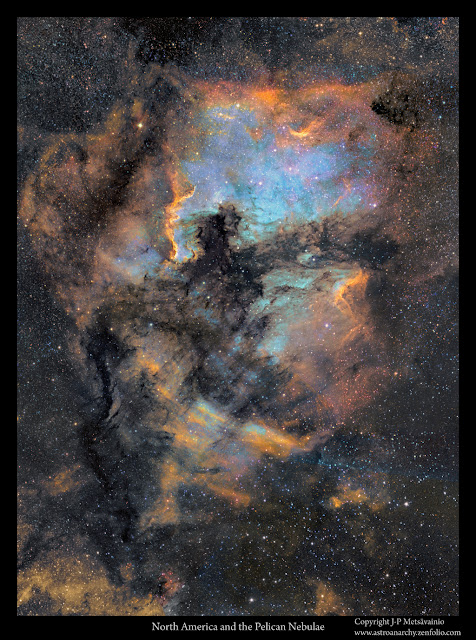COPYRIGHT, PLEASE NOTE
All the material on this website is copyrighted to J-P Metsavainio, if not otherwise stated. Any content on this website may not be reproduced without the author’s permission.
Have a visit in my portfolio
PORTFOLIO:https://astroanarchy.zenfolio.com/
Monday, September 16, 2013
An experimental 3D-study of the Heart nebula, IC 1805
I haven't been able to open up this season yet, since some of my equipment are not yet back from the factory service.
This is an experimental test with a 3D-conversion of my astronomical images. Only real elements from my original image are used, there is nothing added but the volumetric information!
NOTE. This is a personal vision about shapes and volumes, based on some scientific data and an artistic impression.
Heart Nebula, IC 1805, as an experimental 3D-model
NOTE. A largish image, about 7.5MB, let it load for few seconds.
My original image of the Nebula is used for the animation
More 3D-experiments can be seen here:
http://www.astroanarchy.blogspot.fi/search/label/animations
3D-experiments in different stereo formats can be seen here:
http://astroanarchy.zenfolio.com/f359296072
http://www.astroanarchy.blogspot.fi/search/label/animations
3D-experiments in different stereo formats can be seen here:
http://astroanarchy.zenfolio.com/f359296072
Labels:
animations
Saturday, September 14, 2013
Cygnus mosaic in natural colors, reprocessed
I haven't been able to open up this season yet, since some of my equipment are not yet back from the factory service. To keep up my processing skills, I reprocessed the great 18-panels mosaic image of Cygnus. Mapped color version was very much OK but I wasn't happy with natural color version.
The 18-panels mosaic of nebulae in constellation Cygnus
Click for a large image. NOTE. A large image, 2300x1500 pixels and ~5MB
Image is in visual spectrum, red light is emitted by an ionized Hydrogen (H-alpha). Blueish hues are from ionized Oxygen (O-III). NOTE. An apparent size of the full Moon is marked at lower right corner as a scale
This 18-panels mosaic is hot with Canon EF 200mm F1.8 camera lens, QHY9 cooled astronomical camera and the Baader narrowband filter set. Total exp. time is around 120h. More information with the original blog post HERE. Original image is 15.000 pixels wide and over 300MB.
A detail from the image above to show the image resolution
Click for a large image
Not a bad resolution for a 200mm camera lens!
Friday, September 13, 2013
An experimental 3D-study of North America and the Pelican Nebulae
This is an experimental test with a 3D-conversion of my astronomical images. Only real elements from my original image are used, there is nothing added but the volumetric information!
NOTE. This is a personal vision about shapes and volumes, based on some scientific data and an artistic impression.
North America and the Pelican Nebulae as an experimental 3D-model
NOTE. A largish image, about 7MB, let it load for few seconds.
My original image of the Nebula is used for the animation
Click for the large image
Image is in mapped colors
Original blog post about NGC 1499 with technical details
http://www.astroanarchy.blogspot.fi/2011/11/ngc-7000-north-america-pelican-nebulae.html
More 3D-experiments can be seen here:
http://www.astroanarchy.blogspot.fi/search/label/animations
Labels:
animations
Monday, September 9, 2013
Sh2-112, processed with an additional data
I'm waiting to start imaging a new material but there are few items in factory service and I'll need to wait them to come back. Mean while I reprocessed my image of Sharpless object 112 in constellation Cygnus.
Originally I had too little exposures to reveal the background nebulous properly. I noticed, that I actually have a very deep exposures for this object but taken with very different image scale. I have shot this area with a Canon EF 200mm f1.8 optics and the background nebulous stands out very nicely there.
I have developed a new method to combine data from very different sources. It's based on signal to noise analysis, a very weak signal doesn't usually has too much details in it. The weak signal from a low resolution source can be used with a high resolution signal and best of both image types will be used in final image.
http://astroanarchy.blogspot.fi/2012/12/sharpless-112-sh2-112_5.html
Sharpless 112
An emission nebula in constellation Cygnus
The additional data is taken from this wide field image of the same object
Image in mapped colors from the light emitted by ionized elements.
Red=Sulfur, Green=Hydrogen and Blue=Oxygen.
This is a small part of a very large mosaic image of the constellation Cygnus, the mosaic can be seen HERE.
Sh2-112 is located at lower center of the image and the weak background nebulae stand out clearly. Image is shot with a very fast opticla configuration, a Canon EF 200mm f1.8 lens at full open, a cooled astronomical camera, the QHY9 and the Baader narrowband filter set. Total exposure time for this image is around 4h.
Sh2-112 in visual spectrum
Image is in visual colors, combined from the narrowband data.
Technical details:
Processing work flow:
Image acquisition, MaxiDL v5.07.
Stacked and calibrated in CCDStack2.
Levels, curves and color combine in PS CS3.
Optics, Meade LX200 GPS 12" @ f5
Camera, QHY9
Guiding, SXV-AO, an active optics unit, and Lodestar guide camera 8Hz
Image Scale, ~0,8 arc-seconds/pixel
21 x 1200s exposures for the H-alpha, emission of ionized Hydrogen = 7h
3 x 1200s exposures for the O-III, emission of ionized Oxygen = 1h
3 x 1200s exposures for the S-II, emission of ionized Sulfur = 1h
Additional exposures for the background nebulae are shot with a very fast opticla configuration, a Canon EF 200mm f1.8 lens at full open, a cooled astronomical camera, the QHY9 and the Baader narrowband filter set. Total exposure time for this extra data is around 4h.
Additional exposures for the background nebulae are shot with a very fast opticla configuration, a Canon EF 200mm f1.8 lens at full open, a cooled astronomical camera, the QHY9 and the Baader narrowband filter set. Total exposure time for this extra data is around 4h.
Labels:
Narrowband color images,
nebula
Subscribe to:
Posts (Atom)
















